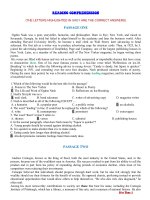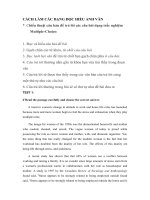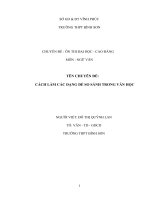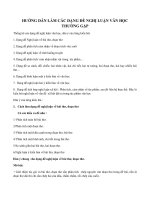CÁCH LÀM CÁC DẠNG ĐỌC HIỂU ANH VĂN
Bạn đang xem bản rút gọn của tài liệu. Xem và tải ngay bản đầy đủ của tài liệu tại đây (161.83 KB, 11 trang )
CÁCH LÀM CÁC DẠNG ĐỌC HIỂU ANH VĂN
* Chiến thuật căn bản để trả lời các câu hỏi dạng trắc nghiệm
Multiple-Choice:
1. Đọc và hiểu câu hỏi đề bài
2. Gạch chân các từ khóa, từ chốt của câu hỏi
3. Đọc lướt bài văn để tìm từ chốt bạn gạch chân phía ở câu hỏi.
4. Câu trả lời thường nằm gần từ khóa bạn vừa tìm thấy trong đoạn
văn
5. Câu trả lời sẽ được tìm thấy trong các văn bản câu trả lời cùng
một thứ tự như các câu hỏi
6. Câu trả lời thường trong bài sẽ có thứ tự như đề bài đưa ra
TEST 1:
I/ Read the passage carefully and choose the correct answer.
A trend in women's change in attitude to work and home life roles has launched
because more and more women begin to feel the stress and exhaustion when they play
multiple roles.
The image for women of the 1950s was the domesticated housewife and mother
who cooked, cleaned, and sewed. The vogue woman of today is proud while
possessing the role as career woman and mother, wife, and domestic organizer. Yet,
the main thing that has really changed for the modern woman is the fact that her
workload has doubled from the duality of her role. The effects of this duality are
being felt through stress, and unfairness.
A recent study has shown that that 68% of women see a conflict between
working and raising a family. It is no wonder since large amounts of stress stem from
a woman's professional career in collaboration with her role as housekeeper and
mother. A study in 1997 by the Canadian Review of Sociology and Anthropology
found said, "Stress appears to be strongly related to being employed outside found
said, "Stress appears to be strongly related to being employed outside the home and is
more strongly felt by women working more hours, especially those working full-
time." The 2001 U.S. Current Population Survey found that many women wish to
have fewer office hours. More and more women want to cut work hours because they
find it difficult to take care of household responsibilities while maintaining a career.
The Female Lifestyle Survey of Great Britain 2004 found that 86% of full time
working women did most of the housework and 77% did most of the child rearing,
which; has made them quite exhausted.
1. The text is about _______.
a. women's difficulties when they have to work both outside and at home
b. women's stress caused by her children
c. women's exhaustion caused by her boss
d. women's preference of multiple roles
2. Being both a career woman and domestic organizer makes women ____
a. happy and independent b. proud and exciting
c. vogue and wonderful d. stressed and exhausted
3. Which idea is not referred in the text?
a. There have been several studies' and surveys on women and their roles.
b. Many women realize a conflict between working and raising a family.
c. All women can do well with their roles both at home and at work.
d. Stress stems from a woman's professional career and her roles as a housekeeper
and mother.
4. The writer _______.
a. advised women to quit their jobs and stay at home for childrearing
b. described the situations that working women suffered from stress and
exhaustion
c. conducted several surveys on women and their work
d. objected to the fact that women worked outside the home
5. Women _______.
a. want to have less work hours
b. want to have more work hours
c. do not want to do housework any more
d. do not want to join social activities
II/ Fill in each numbered blank with one suitable word or phrase.
UNESCO's purpose is to contribute to peace and 'security by promoting
international (6) _____, through education, science, and culture in (7) _____ to
further universal respect for justice, the rule of law, and the human rights and
fundamental freedoms.
UNESCO has 193 Member States and 6 Associate Members. The organization is
(8) _____ in Paris, with over 50 field offices and many specialized institutes and
centers throughout the world. There are also national and regional offices. UNESCO
(9) _____ its objectives through five major programs': education, natural sciences,
social and human sciences; culture, and communication and information. Projects
sponsored by UNESCO include literacy, technical, and teacher-training programs;
international science programs; the promotion of independent media and freedom of
the press; regional and cultural history projects, the promotion of cultural diversity;
international cooperation agreements to (10) _____ the world cultural and
national heritage and to (11) _____ human rights.
The General Conference is a gathering of the organization's member states and
associate members, in which each state has one vote. Meeting every two years, the
members (12) _____ general policies and defines programs for the organization. The
Director-General, who serves as the public face of UNESCO, is elected for a four-
year (13) _____ by the General Conference. The staff currently numbers some 2100.
Two-thirds of them are based in Paris, with the (14) _____ third spread around the
world in UNESCO's 58 field, offices. The Secretariat is divided (15) _____ various
administrative offices and five program sectors that reflect the organization's major
areas of focus.
6. a. collaboration b. diversity c. conservation d. destruction
7. a. work b. result c. order d. requirement
8. a. done b. based c. put d. committed
9. a. catches b. runs c. chases d. pursues
10.a. protest b. secure c. follow d. eliminate
11. a. destroy b. ruin c. preserve d. exchange
12.a. set b. work c. gain d. employ
13.a. tournament b. round c. term d. finish
14.a. amount b. total c. remaining d. leaving
15.a. from b. for c. out off d. into
TEST 2:
I/ Read the passage carefully and choose the correct answer.
The primary attraction of snorkeling is the opportunity to observe underwater life
in a natural setting, such as coral reefs, fish, starfish, and mollusks. Other organisms
that can be seen while snorkeling include various forms of seaweed, jellyfish, shrimp
and $ea turtles. Snorkeling requires no special training, only the ability to swim and to
breathe through the snorkel. However, it is considered advisable that one get some
instruction from a tour guide, dive shop, or equipment rental shop, any of which often
can be found around popular snorkeling locations. Instruction generally covers
equipment usage, basic safety, what to look for, and what to look out for, including
how not to damage fragile organisms such as coral. As with scuba diving, it is always
recommended that one, should not snorkel alone, but rather with a friend, a guide, or a
tour group.
Swim fins used in snorkeling are usually longer than those used in diving.
Snorkel is a tube about thirty centimeters (twelve inches) long, usually J-shaped, fitted
with a mouthpiece, and constructed of rubber or plastic. It is used for breathing air
from above the water surface when the mouth and nose are submerged, either when
snorkeling or during a surface swim before or after scuba diving. The snorkel usually
has a piece of rubber that attaches the snorkel to the outside of the strap of the diving
mask, as sticking the snorkel in between the strap and the mask could cause the mask
to leak, or risk losing the snorkel should the diver choose to switch to scuba.
Typically, the diving mask also serves to prevent breathing through the nose, so
that one is forced to breathe through the snorkel. This also provides some negative
pressure which helps keep the .mask sealed against the face, though attempting to
breathe out through the nose can break this seal and fog the mask.
1. Snorkeling ________.
a. offers divers an opportunity to observe marine life
b. needs a very special training
c. does not require an ability to swim
d. is too dangerous for everybody to enjoy
2. We cannot get instructions for snorkeling from ________.
a. a college b. a tour guide
c. a dive shop d. an equipment rental shop
3. A snorkeler should not ________.
a. rent diving equipment b. use any equipment
c. dive with a friend d. dive alone
4. The snorkel ________.
a. is a long rope b. has swim fins
c. is made of rubber or plastic d. is longer than 12 inches
5. The snorkeler breathes through his ________.
a. nose b. mouth c. fin d. face
II/ Fill in each numbered blank with one suitable word or phrase.
Scuba diving is a beautiful (6) _____, which allows people to view a whole
different world. We enter (7) _____ unknown world in which the danger of scuba
diving has been taken into account. The dangers all into two groups: those in the
ocean itself and that of the individual.
There are (8) _____ many things that the beginner diver needs to remember and
understand. A comprehensive scuba diving course is (9) ___ because there are
lessons which you need to know and understand before even going near the ocean.
In all the parts of the training, always diving with a partner is (10) _____ to be
very important to reduce danger and the diver and hid friend can observe each other at
all times during any dive. It is advisable to have a partner who is a more experienced
diver with a new diver, or someone who .is not confident (11) _____.
The reason for learning skills which is prior to getting into the ocean has two
effects. The first one is the (12) _____ to know what to do in a situation. The
second one is to have the confidence to carry out the actions without panic. Panic is a
danger that will take away the taught skills as it is an emotional response.
The other dangers of scuba diving are in the (13) ___ life. Having some
knowledge of the underwater life of the area you are diving in, can make you (14)
_____ of the risks. This means you can avoid animals which may become aggressive
when approached. Also you need to know the poisons or sharp teeth that could be a
problem in this world, which is new to you.
The many dangers of scuba diving are real and knowing what to expect and. How
to deal with it can (15) _____ you safe.
6. a. way b. encouragement c. experience d. sport
7. a. a b. an c. the d.
Ø
8. a. so b. too c. far d. very
9. a. promised b. told c. allowed d.
required
10. a. risen b. appeared c. seemed d. considered
11. a. either b. enough c. so d. too
12. a. able b. unable c. ability d.
enable
13. a. mountainous b. human c. marine d. wild
14. a. aware b. interested c. excited d. popular
15. a. keep b. help c. assist d.
protect
TEST 3:
I/ Read the passage carefully and choose the correct answer.
Plants and animals hold medicinal, agricultural, ecological value. Endangered
species must be protected and saved so that future generations can experience their
presence and value.
Plants and animals are responsible for a variety of useful medications. In fact,
about forty percent of all prescriptions written today are composed from the natural
compounds of different species. These species not only save lives, but they contribute
to a prospering pharmaceutical industry worth over $40 billion annually.
Unfortunately, only 5% of known plant species have been screened for their
medicinal values, although we continue to lose up to 100 species daily. The Pacific
yew, a slow-growing tree found in the ancient forests of the Pacific Northwest, was
historically considered a "trash" tree. However, a substance in its bark was recently
identified as one of the most promising treatments for ovarian and breast cancer.
Additionally, more than 3 million American heart disease sufferers would die within
72 hours of a heart attack without digitalis, a drug derived from the purple foxglove.
There are an estimated 80,000 edible plants in the world. Humans depend upon
only 20 species of these plants, such as wheat and corn, to provide 90% of the world's
food. Wild relatives of these common crops contain essential disease-resistant
material. They also provide humans with the means to develop new crops that can
grow in inadequate lands such as in poor soils or drought-stricken areas to help solve
the world hunger problem. In the 1970s, genetic material from a wild corn species in
Mexico was used to stop a leaf fungus that had previously wiped out 15% of the U.S.
corn crop.
Plant and animal species are the foundation of healthy ecosystems. Humans
depend on ecosystems such as coastal estuaries, prairie grasslands, and ancient forests
to purify their air, clean their water, and supply them with food. When species
become endangered, it is an indicator that the health of these vital ecosystems is
beginning to unravel. The U.S. Fish and Wildlife Service estimates that losing one
plant species can trigger the loss of up to 30 other insect, plant and higher animal
species. The northern spotted owl, listed as threatened in 1990, is an indicator of the
declining health of the ancient forests of the Pacific Northwest. These forests are the
home to over 100 other old-growth dependent species, which are at risk due to
decades of unsustainable forest management practices. Pollution off the coast of
Florida is killing the coral reefs along the Florida Keys, which serve as habitat for
hundreds of species of fish. Commercial fish species have begun to decline, causing a
threat to the multi-million dollar tourism industry, which depends on the quality of the
environment.
1. Plants and animals _______.
a. contain medicaments
b. will not exist until the future generations can experience their value
c. do some harm to medication
d. take no responsibility for medication
2. Plants and animals _______.
a. take up all recent prescriptions are
b. play no role in pharmaceutical industry
c. can be used to save lives
d. cause difficulty to pharmaceutical industry
3. According to the text, _______.
a. human beings do not like to use plants as medicine
b. human beings depend on plants for food and medicine
c. there is no disease-resistant material in edible plants
d. edible plants do not include wheat and corn
4. Which sentence is true?
a. Humans do not depend on ecosystem.
b. The loss of one species may lead to the 16ss of others.
c. Unsustainable forest management practices have no effects on species.
d. The coast of Florida does not suffer any pollution:
5. The word trigger has a close meaning to _______.
a. cause b. pollute c. contaminate d. decline
II/ Fill in each numbered blank with one suitable word or phrase.
There are a (6) _____ of causes that can contribute directly or indirectly (7)
_____ the extinction of a species or group of species. Just as each species is unique,
and (8) _____ is each extinction. The causes for each are varied – some subtle and
complex, others obvious and simple. Most simply, any species that is unable to (9)
_____ or reproduce in its environment, and unable to move to a new environment
where it can do so, will (10) _____ out and become extinct. Extinction of a species
may come suddenly when a healthy species is wiped out completely, as when toxic
pollution makes its entire. (11) _____ unlivable; or may occur gradually over
thousands or millions of years, such as when a species gradually loses out in (12)
_____ for food to better adapted competitors.
The question of whether more extinction in the fossil record have been caused by
evolution or by catastrophe is a subject of discussion. When talking about species
extinction has been raised, most expert concern with the (13) _____ of climate
change and technological disasters. Currently, environmental groups and some
governments are concerned (14) _____ the extinction of species caused by human
beings, and are attempting to combat further extinctions through a variety of
conservation programs. Humans can cause extinction of a species through
overharvesting, (15) _____, habitat destruction, introduction of new predators and
food competitors, overhunting, and other influences.
6. a. popularity b. differences c. variety d. many
7. a. to b. for c. with d.
at
8. a. otherwise b. so c. but d. or
9. a. damage b. deforest c. disappear d. survive
10. a. go b. put c. die d. take
11. a. nature b. reserve c. diversity d. habitat
12. a. compete b. competition c. competitor d. competitive
13. a. effects b. efforts c. destructions d.
punishment
14. a. for b. at c. about d.
against
15. a. pollution b. planting c. raising d.
agriculture
Consider activities that most take for granted, particularly those who live in
industrialized nations: drinking a glass of water; driving a car or traveling by mass
transportation; living in a decent house or apartment; using modern household
appliances; using tools to build, fix and repair; even breathing fresh air. These
activities improve our quality of life. Have you considered that to do all of the above
requires the availability of natural resources, whether used as raw materials or in
finished products?
The United Nations predicts that the global population will increase from the
present 6.65 billion to 7.95 billion by the year 2025. At the same time, the world is
becoming more prosperous. The average person is consuming more food, water,
energy and metals. Multiple millions in nations that were once poor are now moving
into the middle class. They are driving cars, acquiring household appliances, using
electronic gadgets and adopting high-protein diets, similar to Western industrialized
nations. The subject of natural resources has been in the news for years. The media
has long reported that the world's supply of oil, minerals, fresh water, and lumber are
in danger of running out. Yet very few people take this seriously.
Within the next 50 years, the world's population is projected to rise by 40%. This
growth, coupled with increasing industrialization and urbanization, will result in
greater demand for water. Water will become much scarcer. The United Nations
figures suggest that there are around 300 potential conflicts over water all over the
world. According to the World Health Organization (WHO), about one-sixth of the
world's population lacks access to clean water, while 40% are without access to
proper sanitation services.
16. Which future problems are referred in the text?
a. industrialization and transportation b. natural resources and water
c. household appliances and food d. cars and tools
17. The first paragraph means that _______.
a. all things that make our lives convenient and comfortable need natural
resources
b. people who live in industrialized countries travel everywhere by car
c. people can enjoy more and more fresh air in the future
d. we need more finished products than raw materials
18. According to the second paragraph, _______.
a. population will decrease b. many people will become poorer
c. people use more food and energy d. there will be no poor people
19. Natural resources _______.
a. will never be used up
b. have not ever been mentioned by the media
c. have been the subject of the media for many years
d. are being renovated .
20. According to the text, _______.
a. industrialization and urbanization have greater demand for water
b. clean water is always available for everybody all the -time
c. we will find more and more sources of safe water
d. everybody on earth :will be supplied enough safe water in the future









